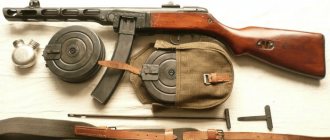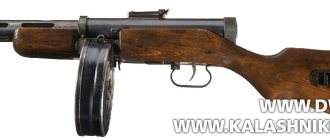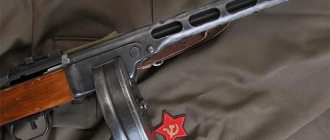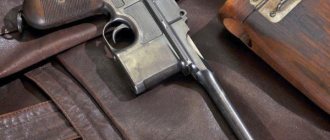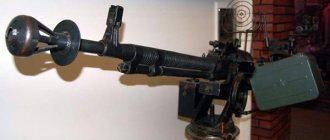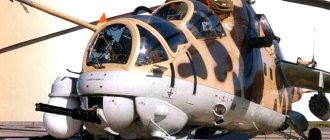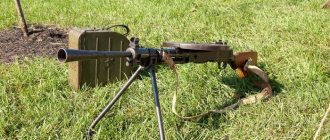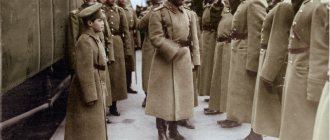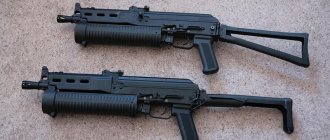Reasons and process of creation
Drawing conclusions from the Soviet-Finnish War (1939 - 1940), the leadership of the USSR gave the order to develop a modern and technologically advanced submachine gun (PP). The new weapon was supposed to match the combat characteristics of the PPD-34/40 (Degtyarev PP), but be easier to manufacture.
By the fall of 1940, G. Shpagin and B. Shpitalny presented their projects to the commission of the People's Commissariat of Armaments.
At the end of November, the Shpagin design bureau produced 25 products, the Shpitalny design bureau produced 15 units intended for testing tactical and technical characteristics. Along with the presented samples, PPD-40 also took part in the tests.
The tests included testing for structural strength, accuracy of fire, combat rate of fire and weight-dimensional characteristics.
By the end of the tests, the commission concluded that the Shpagin submachine gun was more suitable for the needs of the Soviet armed forces. Since it has better reliability, its parts are less susceptible to wear, with a mass equal to the PPD, it is easier to manufacture, and is not much inferior to the Shpitalny PP in accuracy and magazine capacity (but it weighs 1.5 kg more).
As a result, in December 1940, a decree was signed on the adoption of Shpagin's software and the start of its production. The project presented by Shpitalny was sent for revision, citing the low reliability of the automation.
2.4.6.10. Polev's bullet
2.4.6.10. Polev's bullet
The easiest way to load cartridges with a Polev bullet: the bullet in a container and with a wad-stabilizer is sent directly to the gunpowder ( Fig. 63
). The weight of a 12-gauge bullet is 31.5 g, of which 2 g is in the container and 3 g in the wad-stabilizer. The weight of “Falcon” gunpowder for a 12-gauge cartridge is 2.2 g (for guns weighing 2.9–3.0 kg - 2.1 g).
Rice. 63. Cartridge with Polev bullet
In no case should you increase the charge of gunpowder for a Polev bullet: thanks to the powerful seal, the Polev bullet significantly increases the pressure in the barrel. So, already with the Sokol weighed at 2.4 g, the average maximum pressure jumps to 750 kgf/cm? instead of the permissible 663 kgf/cm?. For 16-gauge cartridges, the charge of Sokol gunpowder is 1.8–1.9 g. When determining the charge size, we recommend focusing on charges with polyethylene wads. Capsule "Zhevelo". V. Polev gives the following recommendations on equipment.
“When using plastic cartridges, the head should be inserted all the way, and it will push the lobes of the container apart, the projectile will enter the sleeve with tension and can be held without rolling the barrel neck. This will allow the sleeve to be used multiple times. When using the sleeve repeatedly, however, it is necessary to ensure that its length does not increase beyond 70 mm. Rolling a plastic sleeve longer than 70 mm impairs the accuracy of shooting a bullet from a gun with chambers 70 mm long.”
Many manuals recommend using rolled plastic sleeves. Rolling a paper cartridge does not affect the accuracy of fire.
It is necessary to pay attention to the correct installation of the container: so that one or both of its parts are not turned over to the other side (see carefully the figure in the equipment manual). If the Polev bullet container fits freely into the cartridge case, such bullets cannot be used: combat performance will be significantly reduced due to poor sealing. The Polev bullet container must fit into the plastic (paper) sleeve with an interference fit.
The second model of the Polev bullet (with an expansive void) is significantly superior to other models of bullets available to hunters in accuracy, range, and striking effect, but, like any expansive bullet, it is afraid of dense thickets.
Hunter V. Karpov upgraded the 16-gauge Polev bullet to a 20-gauge bullet for firing from the MTs20-01. At the same time, the diameter of the bullet (14.4 mm) remained the same, and the diameter of the wad-obturator was reduced on a lathe to 15.6 mm with the removal of the obturating skirt.
The 16-gauge Polev bullet, after upgrading to 20-gauge, weighs 24.55 g, including 2.15 g for the plastic stabilizer. For insurance, each bullet is driven through calibers 14.5 mm - lead part, 15.6 mm - plastic. The lead part of the bullet itself is fixed in the stabilizer to the base, and not as when equipping standard bullets with some clearance.
The method of loading such a cartridge is: paper case, “Zhevelo-Powerful” capsule, “Falcon” powder weighed 1.7 g in summer, 1.8 g in winter, polyethylene powder wad. The side surface of the wad is oiled for any season. The wad is sent to the gunpowder with a force of up to 10 kg. Then a 5-mm felt wad is sent, cut out with a die cutter with a diameter of 15.8 mm, which is also greased around the circumference to a depth of 3 mm and sent into the sleeve with the same force. By inserting a felt wad, improvement of obturation, shock absorption, raising the bullet to the height necessary for rolling the cartridge case is achieved, reducing the impact after the powder wad leaves the barrel to the bottom of the bullet.
Instead of plastic petals, liter kefir packaging is used as a carrier (concentrator) of the bullet in the barrel. The dimensions of one petal (two in total) are 19×22 mm in such a way that the carrier fits tightly to the leading edge of the stabilizer and extends to the level of the bullet head cut. Having inserted the stabilizer into the cartridge case, cover the bullet with petals and lower it until it stops on a felt wad. The bullet is sent to its place with a pestle with felt glued to the end so as not to deform the top of the bullet and not to disturb its streamlining. For better rolling, the cut of the sleeve is wiped with paraffin. The twist is made with a funnel in the center for the bullet head to fit into. The loaded cartridge is driven through a 17.0 mm caliber. At a distance of 100 m from the MTs20-01 with an optical sight, the dispersion diameter of the bullets was 12 cm.
Description and performance characteristics
The operating principle of the automatic Shpagin machine gun is based on a free-moving bolt and the use of recoil energy. The mainspring is cocked and activated when the trigger is pressed. Afterwards it straightens, which leads to the bolt moving forward and puncturing the cartridge case.
After the shot, the bolt, due to the powder gases, moves back to its original position.
The spent cartridge case flies out and a new charge takes its place. The ammunition is fed from a drum and sector type magazine. Hook type fuse. Around the barrel is a metal casing with oval holes and a bevel at the end. This innovation by Shpagin protected the fighter’s hands from burns and at the same time worked as a recoil compensator.
Looking at the large-scale cut-away plan of the PPSh submachine gun of the 1941 model, you can notice that the parts depicted on it are extremely simple and reliable.
Such design features allow it to be assembled on non-core production lines. For example, in tractor factories. The entire structure is made of steel, the butt is wooden (mostly birch). Parts are made by cold stamping and electric welding.
PP Shpagina has the following technical parameters:
- Weight: Without magazine – 3.6 kg. With a drum-type magazine - 5.3. With sector – 4.15 kg;
- Length: total product – 84.3 centimeters, barrel – 26.9 cm;
- Ammunition used: 7.62x25 mm TT, pistol;
- Caliber: 7.62 mm;
- Firing speed: up to 1000 rpm;
- Initial bullet speed: 500 m/s;
- Firing mode: automatic, semi-automatic;
- Firing distance max/effective: 500 m / 200 – 300 meters;
- Power type: drum (71 cartridges) and sector (35 cartridges);
- Sights: static, open type at 100 m and equipped with a folding line - 200 m.
Smooth bore bullet
"Paradox"! I read a lot about this device. Previously, they even produced guns with such drilling! This miracle was called “supra”! But apparently this device was not particularly popular and production was quickly closed. We remembered when guns came with different muzzle attachments and screw-in chokes!
Since this attachment was not included in the kit of my gun, I decided to rectify the situation by purchasing it! In the city of Rostov-on-Don, 5 copies of this product were examined! It should be noted that the nozzles were made of different lengths and pitches of rifling! But I already knew what exactly I needed! Pleasure in those years was not very cheap! But I really wanted to try it, and in principle there was money! Here I am the owner of the “Paradox”, with the maximum permitted length of the rifled part (14 cm)!
Of course, the attachment looks like a combat one, but it was used often in its time!
Well, now the cartridge!!! But here I ran into a problem! Bullets for the Paradox were in short supply, or simply not produced enough! Still found it! Actually the “paradox” bullet itself and the “paradox” bullet called “lightning”! Both bullets are heavy, of course (34 and 36g), but not critical, especially for the MC!
I'll take a little break! Reading articles and hunting forums, I noticed that many are criticizing this attachment for nothing! Especially on Hansa! The topic is called (Paradox is complete bullshit!) Comrades, they are screwing with the “paradox” with anything they can get their hands on, just not with a bullet designed for this attachment! And they are also trying to justify the results of the shooting, blaming that bullets fly better from a smooth surface! Now, armed with cartridges, another young comrade wants to achieve outstanding results shooting with a short “saiga” and a 9 cm nozzle! At the same time, he loads some kind of homemade bullet with a “Falcon” weight of 2.6 to 2.8 g. This is no longer funny! True since 2.7. I haven’t decided to shoot yet! In response to my proposal to reduce the powder weight to at least 2.3g, my comrade doubted the bullet’s flight range! When asked what range he has in mind or wants to achieve, he is still modestly silent! Well, that's it, think out loud!
Now I'm confused with the cartridge! How strange it is that the “paradox” bullet didn’t hit me, no matter how hard I fought! But “lightning” is not bad at all! True, having loaded two cartridges, I decided to fire it down the barrel! I was shocked!!! 6 of the 8 remaining did not go further than the chamber! I measured it at the waistband, 18.8mm!!! I had to use a screwdriver and a file to adjust it! But the flight was not bad!!! At 50 meters, three bullets in a cigarette pack!!! I load it this way, any cartridge case, the main thing is that the bullet fits into the tension, the primer is usually KV-209, 2.3g. "Falcon" in winter, 2.2 years. in summer. For gunpowder Ryazan seal, ungreased felt wad about 10mm, cardboard spacer 0.5mm, VP 10mm, bullet, twist! With one wad, it often breaks off the rifling!
Why is this even necessary?! The main object of the hunt, oddly enough, was the black trail hare, wolverine! But all this is difficult! Out of three shots at a hare, all about 100 meters, one hit! The head was missing! Of course, shooting from a smooth one, even with a “paradox”, depends on luck at such a small object! But it is possible!
Can anyone use this device?
I'd love to read the reviews! Modified January 11, 2015 by himgol
Advantages and disadvantages
Like most types of weapons designed before and during the Great Patriotic War, the PPSh was extremely simple and effective. This weapon was appreciated not only by Soviet soldiers, but also by soldiers of the Allied countries and even in the Wehrmacht.
The Shpagin machine gun also had shortcomings, some of which were corrected already in 1942.
Briefly about the advantages
- Ease of production. The PPSh was assembled from spare parts made by cold stamping and spot welding. This did not require manual modification and saved time on machine hours. PPSh were even assembled by Belarusian partisans from parts made at home, without drawings;
- High rate of fire. The drum magazine was fired in ten seconds, which made it possible to create a high density of fire at a short distance, filling the enemy with hot lead. SMGs were mainly used in conditions of dagger combat: clearing trenches during tank landings, urban battles. In particular, for battles in urban areas, the PPSh-41 with a sector magazine was used, which increased the mobility of the serviceman.
Briefly about the disadvantages
- High weight and inconvenience. The simple design of the PPSh revealed a serious drawback - heavy weight. It weighed 5.3 kg with a drum magazine loaded. In addition, the fighter carried with him more ammunition and 2 spare clips. The problem was partly solved by introducing a smaller sector magazine. It had less mass and took up much less space;
- The drums of one PPSh did not fit the other. Cold stamping, although it produced a fast pace of product production, made each sample unique. In particular, this concerned cartridge power elements. If it was lost, it was extremely difficult to find a replacement, and given that only 3 magazines were produced with each barrel, this created a real problem;
- The high rate of fire led to quickly running out of ammunition. In fact, the fighter carried with him 3 equipped drums. A total of 223 rounds. With a rate of fire of 1000 rounds per minute, the ammunition was consumed very quickly. After which the soldier had to begin equipping the clip with new ammunition. In the conditions of current fire contact, this is very difficult. The problem of equipping the magazine with cartridges also aggravated the situation. It was difficult and if even one cartridge was misaligned, I had to start all over again.
- Some design flaws: a crossbow when dropped, the magazine falling out of the mount;
- Ease of manufacture did not mean high wear resistance of parts; this led to a loss of reliability of the machine. In battle conditions, this was an important factor. The battles took place in urban conditions, on rough terrain, in trenches. All these places were not clean. This claim mainly applies to non-core factories.
Bullet shells for shotguns
Photo by the author
In Russia, as well as throughout the world, work continues on the creation of bullets of various designs for shotguns, making it possible to reliably hit large animals at distances of up to 100 m.
In the article “Bullets for a smooth barrel” (“ROG” No. 6, 2012), I talked about the “Tandem” bullets by designer S.G. Mitichkina. In this article we will talk about Polev’s lead bullet, the recently appeared steel bullet shells of M.Yu. Ivanov, as well as about the feathered bullet of D.I. Shiryaev for the Zenit cartridge.
BULLET FIELD
With the purchase of the MTs 21-12 shotgun, I was faced with the question of selecting the optimal bullet for it. In the magazine “Hunting and Hunting Management” (No. 11, 1984) I read an article by engineer Izhmekh I. Izmetinsky “Shooting with a bullet from a smooth-bore weapon.”
This is what he wrote in it about the 12-caliber lead bullet developed by designer V.V. Polev: “This bullet is devoid of the main disadvantages inherent in modern bullets for smoothbore guns, and at the same time has three main advantages: the absence of any additional wads and gaskets; pronounced sweep, which in combination with a light wad-stabilizer of large diameter ensures stable flight along the trajectory, always with the head part forward; using the deformation of the lead part for a reliable connection with the stabilizer wad.”
The designer recommends loading bullet cartridges as follows. A sample of Sokol gunpowder, reduced by 0.2 g from that indicated on the package, is poured into the primed cartridge case; a bullet with facings, mounted on a wad-stabilizer, is inserted into the case, then added to the gunpowder, after which the case is rolled. The designer warns: “Do not use wads and gaskets!”
By test shooting from a rest at a distance of 80 m, I achieved a dispersion diameter of 16 cm. At a distance of up to 50 m, I never missed an elk. What is there! He hit a sitting hare with this bullet. Some hunters believe that such a bullet has high penetrating power, and for this reason the animal, even if beaten in place, does not always go down. I agree with the first statement, but dispute the second.
Once, when I was working as a game manager, having run around in the pens while serving very important people, I stayed in the first room in the hope of resting while the corral was being organized. Sitting down on a stump and leaning against a birch tree, I truly relaxed.
About 10 minutes later, I heard the slight crackling of dry branches opposite me. And it’s necessary! He was coming straight at me - not running, but walking! - elk. I placed my elbows on my knees in anticipation of the beast. Having let the elk go about 30 steps, I shot him in the chest. When cutting up the animal, everyone noticed that the bullet entered the chest and, having passed along the entire body, exited above the tail.
In subsequent years, V. Polev developed the Poleva-2 bullet with a sharper tip, an original polyethylene shank, with two side plates that separated in flight and a shutter pan.
The dispersion diameter at a distance of 100 m was about 10–13 cm. Then the designer proposed a modified Poleva-3 bullet, which differed from the Poleva-2 by the presence of an expansive funnel in the head part. And then, taking into account the comments of hunters, for shooting larger animals he proposed the Poleva-4 bullet with an expansive funnel in the nose and a mass of 40 g. The dispersion diameter at a distance of 100 m was 9 cm.
According to Polev, in some series, when shooting the bullets he created, at a distance of 100 m he was able to achieve dispersion not exceeding 4 cm in diameter. Currently, the designer is improving a steel bullet projectile. Of all the bullet shells of the V. Polev family, the most accurate is the Poleva-3 Sport bullet. In a correctly assembled cartridge, with Italian MBx36 and M92S powders, it showed a speed of 500 m/s and exceptional accuracy.
BULLET SHELL M.YU. IVANOVA
The designer proposed steel bullets for 12 (12/76, 12/89) and 20 calibers. In the head of the bullet there is a funnel from the drill, which, according to the designer, “due to the cumulative effect, enhances the stopping effect.”
As far as I know, the cumulative effect is created, for example, when hit by an armor-piercing projectile, the charge of which has a funnel in the front part, forming the direction of the cumulative jet. M. Ivanov probably meant expansive action. It is recommended to use these bullets when loading 12 gauge magnum (12/76) and supermagnum (12/89) cartridges. In particular, such a cartridge will be good for barrels with paradox drilling. In this case, according to the developer, better results are obtained in terms of accuracy and stopping action.
When using Sunar-Magnum 42 gunpowder, the pressure in the barrel bore will not exceed 1050 Bar, the V3 speed (3 m from the muzzle) will correspond to 443-455 m/s.
It is allowed to use such bullets in guns with choke constrictions of no more than 0.5 mm and in guns with a 70 mm chamber, while the brand of gunpowder and its weight are selected individually depending on the mass of the bullet. Since equipping cartridges is a responsible matter, connected not only with the defeat of the animal, but also with the safety of the hunter himself, I present the designer’s recommendations verbatim.
So, Mikhail Yuryevich recommends loading cartridges in the following sequence:
1. Weigh smokeless gunpowder on a pharmacy or electronic scale (it is recommended to use Sunar-Magnum 42 gunpowder): - for magnum cartridges (12/76), the powder weight corresponds to that indicated on the manufacturer’s packaging; — for 12/70 cartridges, the powder weight is reduced by 0.3 g. 2. Gunpowder is poured into the cartridge case. 3. A BIO shutter-shock absorber or a cut wad container is placed on the gunpowder (the petals for the shot are cut off). 4. The assembled bullet projectile is sent to the BIO wad (or a cut-down wad-container) with the head part up (the head part is heavier, and there is a drill hole on it). 5. Cut the high-density polyethylene shell lengthwise with a knife: - when assembling a bullet projectile for firing from a “paradox” - into two parts; - when assembling a bullet projectile for firing from a smooth barrel - into 3 or 4 parts. 6. The cut parts are put on the bullet projectile. 7. The assembled bullet projectile is sent point-blank to the BIO shutter-shock absorber. 8. The assembled bullet cartridge is rolled. In this case, it is necessary to leave a 10–12 mm edge of the sleeve for rolling. The main thing is that this value is constant. A fluctuation of 1 mm results in a velocity fluctuation of 10 m/s. 9. 20 gauge. A seal is placed on the powder, then a felt, fiberboard or cork wad (it is better to use a set of several wads). Instead of a seal, you can use two thick cardboard gaskets (one for gunpowder, one for the wad).
The author guarantees that when shooting both with a paradox attachment and from a smooth barrel, the dispersion diameter of bullets at a distance of 50 m will not exceed 5 cm, and at a distance of 75 m - 7 cm. The direct shot range for a magnum cartridge is 75 m.
“Dressing” the bullets with cut pieces of polyethylene casing, I drove them all through the barrel, and then loaded 12 rounds into 76 mm long cartridges according to the recommended method. The shooting was carried out using Browning Gold and Benelli shotguns with 0.25 mm nozzles. Shooting at a target through bushes confirmed that this bullet works like an all-terrain bullet.
It pierces a metal plate 4 mm thick by 20 m without any problems. But with accuracy at a distance of 50 m, the results were not entirely impressive. From the Benelli, the dispersion diameter was 19 cm, from the Browning Gold - 12 cm. I attribute such results to the fact that the bullets were driven through the barrel, and I admit that I did not have uniformity in loading the cartridges due to the high " stacks of wads. And the weather that day was -18° Celsius.
FEATHER BULLET
This sub-caliber bullet is designed to be loaded with the 12-gauge Zenit cartridge. It was developed by D.I. Shiryaev, designer-gunsmith of the famous TsNIITOCHMASH. Externally, it is similar to a rocket, and its mass is 12.2 g.
The muzzle velocity of this bullet is almost twice as high as that of conventional rifle bullets, which allows for effective shooting at a distance of up to 300 m with high accuracy. Its dispersion diameter at a distance of 100 m is no more than 14 cm. The bullet has a flat trajectory, within 150 m it is possible to fire with a constant sight.
During repeated shootings on hunts, large animals were hit almost from the first shot at distances of up to 300 m. A shot with such a bullet is characterized by a relatively weak sound and less recoil. The bullet is not prone to ricochets. Unfortunately, the Zenit cartridge has not yet found its way onto the shelves of hunting stores.
Comparing bullet shells from S.G. Mitichkina and M.Yu. Ivanov, I can say that in terms of their capabilities they are approximately the same. But S. Mitichkin’s bullet projectile is quite technologically advanced and easy to load with cartridges, which allows it to be widely used on automatic lines. And not least important is the powder gas pressure of 660 Bar when using it.
Based on dozens of test shootings, I have never been able to achieve the dispersion diameters declared by the designers. True, quite often I shot without an optical sight. In my opinion, you shouldn’t put optics on a shotgun; there are rifled carbines for that. A gun must remain a gun.
And don’t delude yourself into hitting an animal at a distance of 100 m without optics. When testing bullet shells, the shooter is in comfortable conditions: he is calm, shoots while sitting from a rest, taking into account weather conditions and taking into account the sagging of the bullet under the influence of gravity. The hunting situation is completely different, so in order to avoid mistakes, I do not recommend shooting at a distance further than 50–60 m.
In conclusion, we can say that we have a positive trend in the production of slug shells for shotguns. Today, the basic requirements for them can be summarized in the following formulation: the projectile must have accuracy like Polev’s bullet, lethality like Mitichkin’s and Ivanov’s bullets, and range like Shiryaev’s bullet.
If scientists and designers continue their search in the indicated directions, then perhaps over time we will have smooth-bore hunting rifles with bullet shells that will be equal in characteristics to rifled weapons or surpass them.
One Russian scientist involved in the creation and testing of the Large Hadron Collider said that based on the data obtained, in the near future it will be possible to create a gun that will hit a 2x2 m shield at a distance of 30 (!) km.
Victor Gurov June 28, 2012 at 00:00
Why not PPD
The Soviet command never took the PP seriously. It was considered a weapon for the police and gendarmes. However, some Soviet designers proactively developed projects for their submachine guns.
One of these people was Degtyarev. Its PPD-34 was mass-produced and mainly served in the ranks of the NKVD border service.
After the Winter War with the Finns, who massively used Suomi PP. The leadership of the Red Army urgently instructed Degtyarev to finalize the PPD-34.
And in the winter of 1940, he presented a new modification of his project - PPD-40.
By the beginning of the Second World War, about 90 thousand copies of it were produced.
At the same time, Stalin ordered the involvement of the best gunsmiths in the creation of a new PP, which would be easier to produce, but retain the combat qualities of the PPD-40. The Degtyarev submachine gun itself is complex. To create it, you need high-precision equipment and manual grinding.
Bullets for smooth barrels with choke constrictions
Photo by the author
Evgeny Gennadievich! Please tell us about the main criteria for choosing bullets for barrels with a choke or choke choke? Which bullet is equally suitable for the above tapers? Sincerely, A. Mityakov, Smolensk
Bullets for smooth barrels with choke constrictions
The main criterion for choosing bullets for smooth barrels with choke constrictions is that the bullet body must pass freely through the choke, and the sealing and centering bands and ribs must be crushed. This principle is expanded or multiple, but always very clearly indicated in the passports of all smooth-bore guns for which manufacturers allow firing bullets.
This is the main condition for safe shooting from smooth-bore weapons with the advent of guns with muzzle narrowings in the 19th century. Detailed shootings of guns from the Birmingham company WW Greener with choke constrictions were reported in the British magazine The Field back in 1874. And the first guns with choke constrictions arose earlier; the American Roger was one of the first to receive a patent in 1866, as WW Greener himself states in his books.
They were shot with shot, but very soon the first bullets for gun barrels with constrictions appeared. The development of the production of bullets for choke constrictions occurred at the end of the 19th - beginning of the 20th centuries in connection with the deployment of mass production of smooth-bore shotguns with choke constrictions in different countries.
The dozen or two bullets that once existed are constantly being replenished with new samples, including in our time, along with lead samples, bullets are being created from brass and steel, cast, turned, stamped. Now the number of different bullets has reached dozens, and these are only the common ones, not counting the numerous experimental and even good homemade ones. I will name a bullet with a long wooden spindle-shaped shank in the style of the tail of an aircraft bomb of the 1930–1940s. This spectacular bullet was created by the venerable Moscow weapons expert Soloviev at the end of the 20th century.
Bullets of a promising design are being modernized as the creators master the basics of aerodynamics, and they are being worked on so seriously that the previous prototype can be recognized only by its name. Thus, the Brenneke bullet of the 1915 model is a cylinder with a larger diameter head; it is sealed with ring bands on it and in the tail.
And the final Brenneke sample from 1935 has a cylindrical body on which oblique side sealing ribs are located. Polev’s bullet has also undergone significant metamorphoses, now in several different samples. There are many examples.
Hunters can choose bullets for a rifle barrel of almost any drill with a different choke size, usually no larger than a choke. Obviously, a bullet suitable for a gun barrel with a strong choke, like a choke, will also be safe for a barrel with a weaker choke, like a choke; it will pass through it more freely.
It would seem that one should limit ourselves to the “bullet through the constriction” principle when choosing bullets, but in fact, hunters are more interested, with safety issues resolved, in the performance of bullets. It is not enough for the bullet to pass through a choke of one size or another; it must also be compacted in the bore.
Choke and choke constrictions are nominal designations, in metric units they are 0.5 mm and 1.0 mm for 12 gauge; Accordingly, for now we will limit ourselves to this caliber, as the most common. Taking into account the fact that for smooth-bore weapons the bore diameter varies over a fairly wide range - the rules of the CIP commission (PMC in Russia) provide for a range of 18.20–18.90 mm, the diameter of the muzzle reach by which bullets should have been selected is different even for one and the same denomination, for example “chok”.
Of course, manufacturers do not produce smooth-bore guns in the entire intended range of bore diameters, but in technology they stick closer to the nominal caliber, the metric value of which for the 12-gauge is 18.52 mm, usually 18.40–18.60 mm. It is clear that the diameter of the muzzle reach is still different.
It is impractical to call any specific bullet equally suitable for different chokes, and there are many bullets and different guns. You will still have to select the optimal bullet by zeroing according to the combat indicators, of course, after preliminary selection based on the geometry of the barrel bore and the muzzle narrowing of your gun.
The requirements for European smooth-bore 12-gauge shotguns when firing a bullet, if provided by the manufacturer, are quite strict: at a distance of 30 m, Brenneke bullets must fit into a circle with a diameter of 40 mm for a gun with a muzzle narrowing of no more than half a dozen.
You can ask your question to Evgeniy Kopeiko by email
Evgeny Kopeiko December 19, 2016 at 00:00
History of PPSh during World War II
The Shpagin submachine gun, also known as PPSh-41, became the most common automatic personal weapon of soldiers of the Red Army (Workers' and Peasants' Red Army).
It was distributed in various branches of the military: infantry, guards units, airborne groups. It was also actively used by partisans operating in German-occupied territory.
Even German soldiers willingly used it instead of the MP-38/40.
The ROA (Russian Liberation Army) of Vlasov also had their own PPSh.
Ease of use made it possible to reduce the training period for recruits. And this is important in conditions of military operations.
This PP has proven itself in tank landings. After breaking through the defense line with tanks, soldiers with PPSh in their hands burst into the enemy’s trenches and used the so-called “trench broom” tactics.
Taking advantage of the high rate of fire, they suppressed enemy soldiers with fire, which left them no chance to survive.
He performed well in urban battles. The Battle of Stalingrad can be called the baptism of fire for this weapon. The fierce battle for the city took place in densely built conditions and numerous confined spaces.
In this kind of battle, the main thing is the rate of fire and the ability to suppress the enemy with continuous fire. The same thing happened in Kharkov and in the spring of 1945 in Berlin.
Options and modifications
During its long existence, the PPSh was modified more than once, and a huge number of types of this machine gun spread throughout the world.
It is impossible to list all of them due to the wide distribution and uncontrolled movement of this software.
Officially, it was supplied to countries such as China, Vietnam, Poland and Cuba.
Factory Soviet models:
- PPSh-41 arr. 1941 – first sample. It was equipped only with a drum magazine and a sight designed for shooting at a distance of up to 500 m.
- PPSh-41 arr. 1942 – differs from the ’41 model by a chrome-plated bore (Increases wear resistance), more reliable fastening of the clip and the elimination of an involuntary shot when falling. It was equipped with an aiming device for shooting at 100 - 200 meters. A sector magazine made of steel 0.5 mm thick (Later – 1 mm);
- PPSh-2. In 1943, a competition was announced for the development of a new submachine gun, which was supposed to be a replacement for the PPSh. The main requirements were maintaining combat qualities, reducing weight and dimensions. The product presented by Shpagin, although it was further simplified in production, did not meet the requirements. The choice fell on the project of the gunsmith Sudakov.
Handicraft and semi-handicraft models:
- “Product No. 86” - were manufactured in Kandalaksha on the territory of plant number 310. Before receiving the drawings, 100 products were produced. All of them were made by hand and their parts were not interchangeable. Like production models, the machine gun was equipped with a drum magazine;
- Many samples of the Shpagin submachine gun were made in the workshops of various partisan detachments operating on the territory of Belarus;
- Jelen - Croatian semi-handicraft modification, which was actively used in the wars on the Balkan Peninsula.
In the ranks of the Third Reich:
- MP.41(r) – captured PPSh-41 converted to the 9x19 “Parabellum” pistol cartridge, common among the Germans. The weapon had a replacement barrel and a receiver for clips from the MP-38/40. In total, about 10,000 pieces were converted.
During the Second World War and after its end, PPSh was produced in many countries. Among them were China, Yugoslavia, Iran, Croatia, Vietnam, Hungary, North Korea, etc.
Basically it was an ordinary Shpagin submachine gun. Only in rare cases were minor modifications made to suit the realities of local industrial potential.
Conversion options
- PPS-50 – Manufactured by Pletta. Uses small caliber ammunition - .22 LR;
- SR-41 Semi-Auto Rifle – Produced by the American arms company “Inter-Ordnance of America”. There is a modification chambered for 7.62x25 and 9x19 mm. Has an increased barrel length. American weapons connoisseurs have always spoken highly of the PPSh-41.
- SKL-41 – developed for the 9x19 cartridge. Start of production 2003
- PPSH 41 SemiAuto is a self-loading modification using a 7.62x25 cartridge. The key feature is an extended barrel (up to 16 inches), a casing without specific and recognizable oval holes. Shooting occurs with the shutter closed. Manufactured by the American company “Allied Armament”;
- VPO-135 – Cartridge 7.62x25. System: self-loading carbine. Date of development: 2013. Produced by the Molot plant;
- PPSh-O - Cartridge 7.62x25. System: self-loading carbine. Date of development: 2013. Produced by the Kovrov plant named after Degtyarev;
- MR-562K "PPSh" - a pneumatic version developed at the Izhevsk plant. Shoots 4.5 mm metal balls. Can fire in bursts.
Cartridges for TT pistol and PPSh assault rifle.
The 7.62×25 mm cartridge for firing from the TT pistol and the PPSh assault rifle is a Soviet ammunition, a unitary bottle-shaped cartridge with a small semi-flange sleeve, copied on the basis of a German cartridge intended for the 7.63×25 mm Mauser pistol. It differs from the original by an enlarged groove of the sleeve and a slightly protruding rim. This is the very first pistol cartridge, as usual copied from the Germans, officially adopted not only by the army, but also by various paramilitary services in the USSR. In addition, it was used in submachine guns PPS, PPD and others.
The story of their appearance in Tsarist Russia sounds standard. German 7.63-mm pistols of the Mauser design model of the 1896 intake model began to appear in Russia in various ways long before the outbreak of the First World War. It is important to note that from the middle of 1908, they were officially included in the list of weapons for combat shooting, permitted for purchase by officers of the tsarist army at their own expense. In addition, during the battles of 1914-1917, their numbers increased significantly due to German and Turkish trophies, after which these pistols were subsequently used everywhere on absolutely all sides and on almost all fronts of the Civil War.
And then the story continued - in the early 1920s, in enemy Germany, for soldiers and officers of the Red Army and members of the All-Union Communist Party, the Bolshevik government purchased several large quantities of German 7.63-mm Mauser pistols and a huge amount of ammunition for them in various ways.
But Russia, as always, did not have enough money, and in the summer of 1929, the formed Artillery Committee made an initial proposal to develop pistols for firing from their own production for the standard 7.63x25 mm cartridge of the Mauser gunsmith.
Some sources report that such cartridges were also produced by the Podolsk Cartridge Plant in the 1920s, but official information on this fact has not been found anywhere. Back in 1930, after a successful series of research and development work, a new pistol cartridge with parameters of 7.62x25 mm was finally chosen as the main standard ammunition for firing from the new Soviet self-loading pistol and in the visible future - and for arming existing and developing submachine guns. The license and necessary equipment for the production of such a cartridge were officially purchased by the Soviet government from the friendly German company DWM. The new, supposedly Soviet-made, pistol ammunition received a slightly modified designation with the index “7.62 mm pistol cartridge produced in 1930.” In preserved sources from the 1930s and later, for example, the Shooting Manual for the submachine gun of the Soviet gunsmith Degtyarev mod. 1934, these cartridges are also called "7.62 mm Mauser cartridges".
Description and modifications of the cartridge
In the complex process of taking root in the USSR, the cartridge received the caliber name as 7.62 mm, unanimously with the rifle and revolver cartridges that were in service with the military formations of the Red Army. In addition, the barrel bore of the weapon itself for the cartridge used was accordingly completely unified with the rifle one (identical barrel cutting parameters), which made it possible to use the same equipment, as well as measuring and control tools, for the production of short pistol barrels and longer submachine guns. Plus the use of a primer from a cartridge tested over the years for the revolver system of the author Nagan, which had a larger diameter than the original, the groove for the automatic ejector on the cartridge case was noticeably enlarged, and accordingly the rate of fire and reliability of cartridge case extraction increased.
The classification of cartridges looked like this.
Cartridge 7.62 Pgl (Pgs, Pgzh) - equipped with an ordinary P bullet, used around 1930, has a steel bullet filled with lead. The 7.62 P-41gl cartridge with the complex P-41 armor-piercing incendiary bullet was generally not accepted for supply to troops at all, but starting in 1941, it was made throughout the war according to temporary technical conditions. A cartridge with a 7.62 PTgl (PTgzh) tracer bullet, designed in 1943, is used to simplify target designation and subsequent fire adjustments, which at the end of the 50s was significantly modernized in order to improve the alignment of the flight trajectories of Pst bullets. The 7.62 P-41gl cartridge, firing an ordinary bullet with a hardened steel core Pst, was somewhat controversial and was adopted to supply the USSR troops in 1951 and their reserves are still large.
The cartridge cases are standard bottle-shaped, with an annular extraction groove, made of special brass or steel: uncoated steel from the military period, then steel clad with tombac and brass-coated steel from the 1945s. When fired from a cartridge with an increased powder charge, the bullet normally accelerates to a speed of 480 m/s and receives solid flight energy and lethal force in the barrel of the Tokarev Tula pistol.
The bullet is strengthened in the muzzle of the case using triple core punching. The cartridge is stabilized in TT pistols when the loader is pushed forward into the barrel chamber with the front end of the cartridge case into a special ledge, and in submachine guns adopted for service this is done by focusing the cartridge case slope on the axial slope of the chamber. Many developers believe that due to its demonstrative power, good flat shooting trajectory and other features, this unique cartridge is the best for combat shooting in submachine guns. Due to the huge production quantities, this ammunition did not have any special collection value. In this photo and from the description below, you can identify your find yourself. But remember that even the oldest cartridge, according to the police, may turn out to be an item similar to ammunition for a TT pistol or a PPSh assault rifle, which may be a reason for bringing you to the police station.
Soviet factories manufacturers of cartridges for PPSh and TT 7.62x25 during the Second World War: 710 Podolsk plant; T Tula plant; 3 - Ulyanovsk; 10 - no information; 60 - plant r. Frunze; 270 - Lugansk plant; 38 - plant r. Yuryuzan; Until 304, it was made by the Kuntsevo plant; 541 - Chelyabinsk plant; 711 – Klimovsky plant
.
Myths and legends about PPSh
Around each weapon there is a huge number of myths associated with it or the people who created it. The Shpagin assault rifle is no exception.
Here is just a small part of these legends:
- PPSh is a copy of the Finnish Suomi assault rifle. This is wrong. Although there is an external resemblance, it is only external. The internal mechanism is different;
- There is a shortage of automatic weapons among Soviet soldiers and, on the contrary, a large number of such weapons among the Germans. The same myth “one rifle for five soldiers.” The Germans often used captured SMGs, precisely because of their lack of weapons of this class;
- PPSh-41 is the best submachine gun of the Great Patriotic War. The truth is that he was like this before the release of PPS-43;
- The last country to remove the PPSh-41 from service is Belarus. This happened in 2003.
Cultural significance of PCA
Along with the legendary “Katyusha” and the three-line Mosin, the PPSh-41 is strongly associated with the weapon of victory of the Great Patriotic War.
The image of a soldier with a machine gun is depicted on numerous historical sites and monuments. Soviet, modern Russian and foreign films show the image of a fighter fighting with this weapon in his hands against the enemy.
This weapon is also the hero of numerous computer games. In them you can run around the fields of virtual war with PPSh at the ready. For people who want to feel the real weight of the PPSh-41, there are prefabricated models made of wood. TARG products are especially popular
Of course, the PPSh is no longer in service with the troops, but it left its mark on history and was, if not the main, then one of the main types of weapons of the Soviet soldier during the Great Patriotic War.
Photo gallery from the museum
Real photos of the PPSH 41 assault rifle, a museum example that was found on the battlefields. The PPSh weapon dates back to 1942 and has the number VG390mmg
Don't forget to leave your comments on the site and share your opinion.
